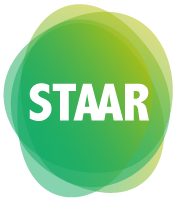
|
Developing and sustaining foundational language skills: listening, speaking, reading, writing, and thinking--vocabulary. The student uses newly acquired vocabulary expressively.
|
||
|
Vocabulary in context
Synonyms and antonyms
Domain-specific vocabulary
Multiple-meaning words
|
||
|
Vocabulary in context
Synonyms and antonyms
Domain-specific vocabulary
Multiple-meaning words
|
||
|
Comprehension skills: listening, speaking, reading, writing, and thinking using multiple texts. The student uses metacognitive skills to both develop and deepen comprehension of increasingly complex texts.
|
||
|
Allusions
Compare texts
Visual elements
|
||
|
Allusions
Compare texts
Visual elements
|
||
|
Inferences
Short stories
Analyze literary passages
Analyze informational texts
|
||
|
Inferences
Short stories
Analyze literary passages
Analyze informational texts
|
||
|
Central idea
Supporting details
Short stories
Analyze literary passages
Analyze informational texts
|
||
|
Central idea
Supporting details
Short stories
Analyze literary passages
Analyze informational texts
|
||
|
Central idea
Short stories
Analyze literary passages
Analyze informational texts
Analyze nonfiction passages
Compare texts
|
||
|
Central idea
Short stories
Analyze literary passages
Analyze informational texts
Analyze nonfiction passages
Compare texts
|
||
|
Response skills: listening, speaking, reading, writing, and thinking using multiple texts. The student responds to an increasingly challenging variety of sources that are read, heard, or viewed.
|
||
|
Text evidence
|
||
|
Text evidence
|
||
|
Multiple genres: listening, speaking, reading, writing, and thinking using multiple texts--literary elements. The student recognizes and analyzes literary elements within and across increasingly complex traditional, contemporary, classical, and diverse literary texts.
|
||
|
Multiple genres: listening, speaking, reading, writing, and thinking using multiple texts--genres. The student recognizes and analyzes genre-specific characteristics, structures, and purposes within and across increasingly complex traditional, contemporary, classical, and diverse texts.
|
||
|
|
||
|
|
||
|
|
Central idea
Supporting details
Central ideas in informational passages
|
|
|
Central idea
Supporting details
Central ideas in informational passages
|
||
|
|
||
|
|
||
|
|
|
|
|
|
Development of ideas
Supporting details
Logical fallacies
Counterclaims
|
|
|
Development of ideas
Supporting details
Logical fallacies
Counterclaims
|
||
|
Author's purpose and craft: listening, speaking, reading, writing, and thinking using multiple texts. The student uses critical inquiry to analyze the authors' choices and how they influence and communicate meaning within a variety of texts. The student analyzes and applies author's craft purposefully in order to develop his or her own products and performances.
|
||
|
Central idea
Author's purpose
Point of view
|
||
|
Central idea
Author's purpose
Point of view
|
||
|
Composition: listening, speaking, reading, writing, and thinking using multiple texts--writing process. The student uses the writing process recursively to compose multiple texts that are legible and uses appropriate conventions.
|
||
|
|
||
|
|
||
|
|
Organization
Transitions
Central idea
|
|
|
Organization
Transitions
Central idea
|
||
|
|
Central idea
|
|
|
Central idea
|
||
|
Conjunctions and transitions
Sentence variety
Misplaced modifiers
Parallel structure
Revision
|
||
|
Conjunctions and transitions
Sentence variety
Misplaced modifiers
Parallel structure
Revision
|
||
|
|
||
|
|
||
|
|
Subjects and predicates
Sentences, fragments and run-ons
Simple, compound, and complex sentences
Subject-verb agreement
Phrases and clauses
|
|
|
Subjects and predicates
Sentences, fragments and run-ons
Simple, compound, and complex sentences
Subject-verb agreement
Phrases and clauses
|
||
|
|
|
|
|
|
Frequently confused words
Homophones
Plural nouns
Common errors
|
|
|
Frequently confused words
Homophones
Plural nouns
Common errors
|
||
|
Response skills: listening, speaking, reading, writing, and thinking using multiple texts. The student responds to an increasingly challenging variety of sources that are read, heard, or viewed
|
||
|
Central idea
Short stories
Literary passages
Informational texts
Nonfiction passages
Compare texts
|
||
|
Central idea
Short stories
Literary passages
Informational texts
Nonfiction passages
Compare texts
|
||
|
Composition: listening, speaking, reading, writing, and thinking using multiple texts--genres. The student uses genre characteristics and craft to compose multiple texts that are meaningful.
|
||
|
Tone
Organization
|
||
|
Tone
Organization
|
||
|
Central idea
Tone
Organization
Facts and opinions
Supporting details
Counterclaims
|
||
|
Central idea
Tone
Organization
Facts and opinions
Supporting details
Counterclaims
|
||
This document includes IXL skill alignments to the Redesigned STAAR. IXL provides skill alignments as a service to teachers, students, and parents. The skill alignments are not affiliated with, sponsored by, or endorsed by Texas Education Agency. IXL and IXL Learning are registered trademarks of IXL Learning, Inc. All other trademarks and registered trademarks and copyrights are the property of their respective owners.